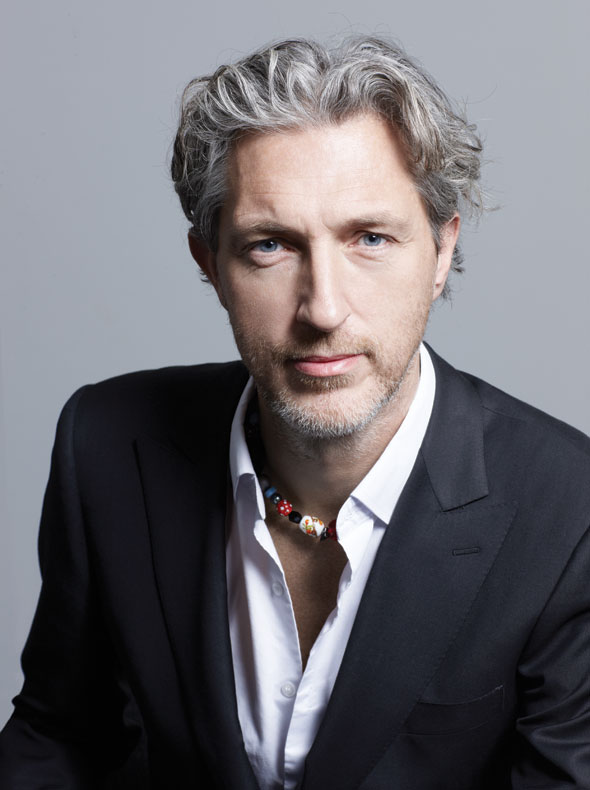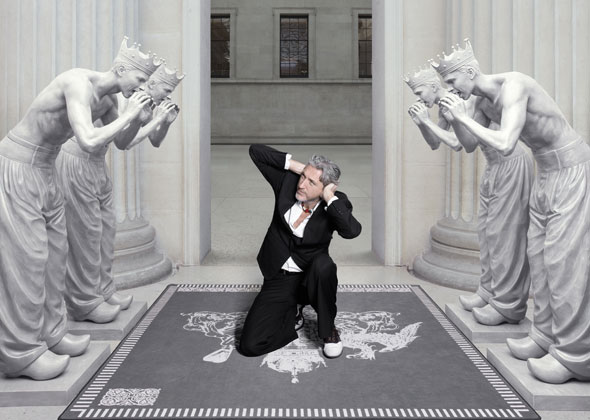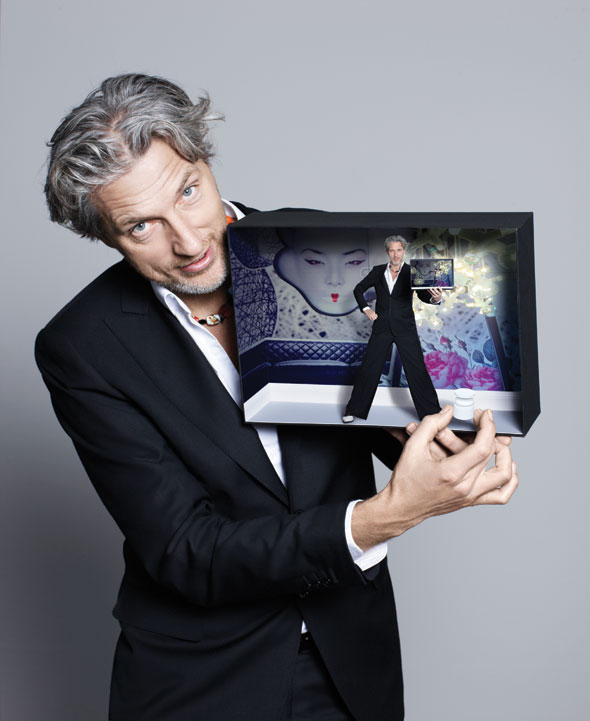
Fighting for a world bearing more sustainability and durability through his cleverly manipulated interior and product designs, Marcel Wanders is the Beethoven equivalent to others in his field. Gaining recognition in the late 90s for his simple structures played against elaborate and opulent designs, any product of his can be appreciated from a mile away with the amount of personality each exudes.
Trained at the Design Academy Eindhoven and graduated from the School of the Arts Arnhem, Wanders evolved from his most prominent piece in 1996, “The Knotted Chair,” which is now permanently exhibited at the Museum of Modern Art in New York. Currently Art Director of Moooi, a design brand co-founded in 2001, Wanders continues to inspire and challenge the world around him.
A master in your sphere of design, how would you personally describe your creative process?
The creative process is, by definition, quite chaotic. It sometimes drives people in our studio crazy because we are such perfectionists. Our approach to product design is pretty much conceptual. We don’t start designing unless we have a great idea. And only if we have a great idea will it guide us to the end result. It’s like the sculptures we do. There’s a block of marble, and it’s got this concept and idea, and trying to find exactly what the client wants by throwing away little pieces of stone to make sure we end up with this one idea in its ultimate existence—its ultimate way. However, interior design is really boring if you make them conceptual. Instead, you really have to make them come alive, and there’s much more time involved in creating but also in experiencing these designs. It’s more like we’re making a composition of music—like an opera—because we find all these different aspects, which all have to work together. Sometimes things really come alive when you take the order out and allow a little bit of chaos for it to come alive and to grow beyond yourself.
With such a strong sense of durability and sustainability in your designs, what initially inspires you with the drive to create them?
A lot of people speak about inspiration, and now it’s a difficult word to calculate meaning from because it’s been misused so much. Today, if you talk about inspiration, you talk about some dude who can go on his bike to the library and find some book on Japanese stuff and then is “inspired.” I think that’s a very superficial way to think about the core of life. I’ve always thought about inspiration in a medieval way. I think knights were inspired to go to war to save virgins—something that really became their destiny, and which was the reason they existed. For me, I know what I’m here for. I know what I want to do in my life. I know why it is important to wake up. Because I want to create a world that is ready for more durability and sustainability. I want to create a world with objects and surroundings that are human—more personal, more romantic and less sterile. These things run through my head all the time because I’m asking myself questions—how to do this—and I get answers. Whether they come in the form of ideas or products, there are different ways to work on the same subject. This “inspiration” is there all the time; I don’t have to look for it. I just have to follow this logic and this personal thinking.

You’ve designed almost everything from Mac Cosmetics to hotels to cell phones. Is there anything you still desire to have the opportunity of designing?
There’s a gap between what I think the world should be like and what it is today. There’s a lot of work for me still to do. With all the various growing cultures in the world, it is much more important than it was a few years ago and something that challenges us as a society—to find ways to show the respect we have for each other. One of the ways I would love to do this is by designing a mosque. As a Westerner, I’d love to pay tribute to the thoughts and visions of other people and to give them—in a very respectful and human way—a space that is meaningful.
Having over twenty years experience in your field, what difficulties did you face as a young designer in getting people to understand the concepts and ideologies behind your early work?
In the first publication I wrote in 1995, the introductory subject is how we can get a world that is more durable and sustainable. It’s not driven only by the idea that we live in our own world that needs to learn to be more fruitful with its resources. And yes, we need to have a world that needs to maintain its existence, but I think it also explains why I’m a designer. I really want to start making objects that people will not even think about throwing away because they are so valuable to them. From a product’s perspective, I would love to make things that are non-recyclable because people would never throw them away. All these ideas of recyclable products are really all just a waste of thinking because we should make designs that should never leave the planet because people love and value them so much.
How would you describe the evolution of your work over the past years?
I started off as a product designer based on very conceptual types of design. I think, already back then, together with Ella and Jurgen, we showed a more humanistic way to it—it was more decorative, sensitive and a little bit different. Later, I decided to set up a company (Moooi), which grew to become an interesting vehicle for myself and tons of other designers who had never had something out in the market before. Of all the designers we’d been working with, I think we probably had twenty designers who had never published things anywhere previously and we were the first to trust them. I’m sure that about two thirds of them are now really big players in the world of design—people like Maarten Baas and Jurgen Bey. We did a lot of hotel design, and now I’ve started my own hotel in Amsterdam. If I do something, I want to sell the designs, but at the same time, I want to buy them. I want to buy what I sell and feel completely true with the things I’m designing, which is why I set up my own company and designing [sic] hotels. Simply making objects better so people will love them more is already a fantastic ecological step. A lot of pieces are thrown away whilst they’re still really good, which is such a waste. We are curating a fantastic exhibition in the beginning of 2014, in the Stedelijk Museum in Amsterdam, that is going to be a turning point for my career and at the same time giving us the moment to really look at ourselves and plan the next steps. I’m planning to open up another part in my design studio where we’re going to make a different type of product that is no longer aiming to draw people towards ecology and sustainability but instead demanding this from people. We’re going to make it a must instead of an opportunity. This part of my studio will not only design but will create the companies that will realize this.
What route do you see design taking in the future?
Design will play an important role in the future; it will hopefully lose its connection to its early beginnings—the idea that designers love minimalism so much is really alien to me. I want to give the best I can to my audience instead of the least I can. I think we need to understand we work for people and that we have to make humanistic works—whatever that means. It is not technocratic. It is romantic and sensitive. And it is these aspects that will carry more importance in the future world of design. I think in a few years, you’ll be entering a house with the heating, lighting, music and sound all included in the rent. And there will be nothing left to buy—so, visually, there will be no more impact. Thus making the houses and their surroundings far more ceremonial than they are today. Just remember when we invented CDs. I mean, who still has them because they love them so much? No one. We want technology to disappear because we want results of it but not the vision of it. I think that’s where design has to evolve. So it will be very technical and morph into something that isn’t so visual but very ceremonial and human from the other side. That’s the area where all poets of their time will work.

What message do you hope people take from you and your work?
It’s really important for people to understand that design has to evolve from being technocratic in a minimalistic world to a truly human world, which, therefore, has to automatically be more romantic, sensitive and more humane. We are designers, and we don’t have to be invisible. I think it’s great if we are artists and we show our faces—who we are and how we think. I think music is more fulfilling if you know the composers behind it—the same with art and knowing the story behind what they create. We don’t have to make abstract objects that nobody knows about. And we want to connect with people and show how much we love our surroundings and how we want to make it beautiful for others.
Text by Katia Ganfield
PHOTOGRAPHY BY Olivia Beasley

